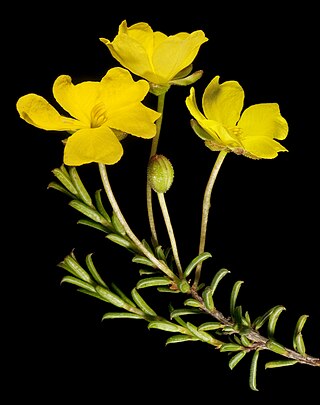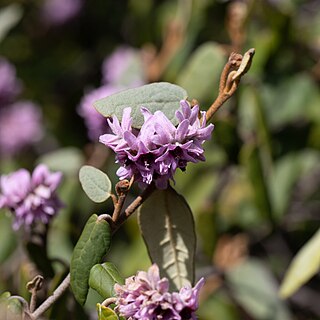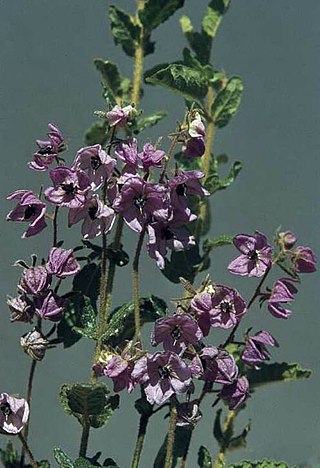
Lasiopetalum floribundum, commonly known as free flowering lasiopetalum, is a species of flowering plant in the family Malvaceae and is endemic to the south-west of Western Australia. It is an erect or spreading shrub with hairy young stems, egg-shaped leaves and pale pink, mauve or white flowers.

Lasiopetalum baueri, commonly known as slender velvet bush, is a species of flowering plant in the family Malvaceae and is endemic to south-eastern Australia. It is a small, greyish shrub with more or less linear to narrowly oblong or narrowly elliptic leaves and groups of white or pink flowers.

Seringia integrifolia, commonly known as common firebush, is a species of flowering plant in the family Malvaceae and endemic to the south-west of Western Australia. It is a small, much-branched shrub, its young growth densely covered with woolly, white or rust-coloured hairs. The leaves are oblong, 8.5–17 mm (0.33–0.67 in) long, more or less glabrous on the upper surface and densely covered with woolly white hairs on the lower surface. The flowers are arranged in small, loose groups with thin, egg-shaped bracts that fall off as the flowers open. The sepal lobes are broad, pointed, mostly 6.5–8.5 mm (0.26–0.33 in) long and the ovary has 5 carpels with about 4 ovules in each. The fruit is a spherical, softly hairy capsule.

Hibbertia commutata is a species of flowering plant in the family Dilleniaceae and is endemic to the south-west of Western Australia. It is a low, erect, many-branched shrub with narrow elliptic to narrow egg-shaped leaves, and yellow flowers with fifteen to thirty stamens arranged around three carpels.

Hibbertia depressa is a species of flowering plant in the family Dilleniaceae and is endemic to the far south-west of Western Australia. It is a prostrate or sprawling shrub with spreading, usually densely clustered, linear leaves and yellow flowers arranged singly or clustered among the leaves.

Commersonia corniculata is a species of flowering plant in the family Malvaceae and is endemic to the southwest of Western Australia. It is an erect to prostrate shrub with 3-lobed, egg-shaped leaves, and white to cream-coloured flowers.

Hibbertia lineata is a species of flowering plant in the family Dilleniaceae and is endemic to the south-west of Western Australia. It is a spreading to erect shrub with linear to narrow egg-shaped leaves and yellow flowers, usually with ten stamens arranged on one side of, and leaning over the two densely hairy carpels.

Hibbertia striata is a species of flowering plant in the family Dilleniaceae and is endemic to the southwest of Western Australia. It is a spreading shrub with linear leaves and yellow flowers usually with thirty stamens arranged in five bundles around five glabrous carpels.

Lasiopetalum bracteatum, commonly known as Helena velvet bush, is a species of flowering plant in the family Malvaceae and is endemic to the south-west Western Australia. It is an erect, spreading shrub with egg-shaped leaves and loose groups pinkish flowers.

Lasiopetalum discolor, commonly known as coast velvet-bush, is a species of flowering plant in the family Malvaceae and is endemic to coastal areas of southern Australia. It is an erect, spreading or sprawling shrub with hairy stems, oblong to egg-shaped leaves and pink or white flowers.

Lasiopetalum glabratum is a species of flowering plant in the family Malvaceae and is endemic to the south-west of Western Australia. It is an erect shrub with densely hairy young stems, egg-shaped leaves and pale mauve-pink reddish-purple flowers.

Lasiopetalum glutinosum is a species of flowering plant in the family Malvaceae and is endemic to the south-west of Western Australia. It is a spreading, multi-stemmed shrub with densely hairy young stems, egg-shaped leaves often with three lobes and bright pink or dark red flowers.
Lasiopetalum indutum is a species of flowering plant in the family Malvaceae and is endemic to the south-west of Western Australia. It is an erect or straggling shrub with hairy stems and pink, cream-coloured or white flowers.
Lasiopetalum laxiflorum is a species of flowering plant in the family Malvaceae and is endemic to the south-west of Western Australia. It is a sticky, straggling subshrub or shrub with many densely hairy stems, egg-shaped leaves, and bright pink and dark red flowers.

Lasiopetalum molle, commonly known as soft leaved lasiopetalum, is a species of flowering plant in the family Malvaceae and is endemic to the south-west of Western Australia. It is an erect or spreading subshrub or shrub with hairy stems, thick and stiff egg-shaped leaves and pink flowers.

Thomasia cognata is a species of flowering plant in the family Malvaceae and is endemic to the south-west of Western Australia. It is a compact, multi-stemmed shrub with wrinkled, narrowly oblong to elliptic leaves and pale pink flowers.
Thomasia discolor is a species of flowering plant in the family Malvaceae and is endemic to the south-west of Western Australia. It is a small, compact shrub with hairy new growth, heart-shaped leaves with wavy, lobed edges, and pink flowers in crowded clusters.

Thomasia macrocalyx is a species of flowering plant in the family Malvaceae and is endemic to the south-west of Western Australia. It is an erect, bushy shrub with densely hairy new growth, egg-shaped leaves with a heart-shaped base and lobed or toothed edges, and groups of pale purple to mauve or white flowers.
Thomasia montana, commonly known as hill thomasia, is a species of flowering plant in the family Malvaceae and is endemic to the south-west of Western Australia. It is an upright to low, ground-covering shrub with hairy new growth, egg-shaped to broadly oblong leaves, sometimes with wavy or toothed edges, and pale purplish-pink to maroon flowers.
Thomasia rulingioides is a species of flowering plant in the family Malvaceae and is endemic to the south-west of Western Australia. It is an erect, open shrub with densely hairy new growth, narrowly oblong to narrowly egg-shaped leaves with wavy edges, and pink to purple flowers.















